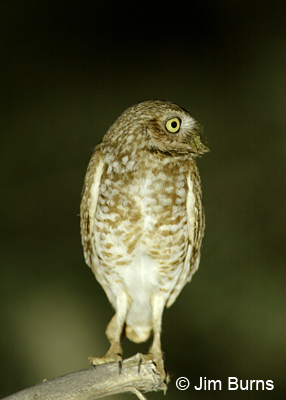
More on that disappearance later, but far more interesting is biologist Neil Losin’s article about Burrowing Owls in the February issue of Birder’s World. In the article, Losin (www.neillosin.com) defines a “tool user” as “any animal that uses a foreign object to influence its environment.” Burrowing Owls have long been known to line the entrance to their underground burrows with dung. Recent research has shown the originally held hypothesis for this behavior may not be correct, and it prompts a change I’ll have to make in an owl program I’ve been giving for several years. There’s no doubt, though, that these captivating diurnal owls are tool users by Losin’s definition.
For many years researchers thought that Burrowing Owls’ curious habit of bringing manure to their burrows was to camouflage their scent from mammalian predators such as badgers, foxes, and feral cats. I had read the theory, it made perfect sense, and I was delighted to have captured this example of avian tool usage for my program. Losin’s article, however, gives us a scientific update. Recent research suggests a more logical and more verifiable reason for the owls’ usage of this seemingly odd tool, based not on what the dung might repel, but on what it attracts to the owl burrow.
If you’ve spent any time out in the desert, you know what a dung beetle is and what a dung beetle does. The male shapes and then rolls a circular ball of dung, fifty times its weight, across the desert floor to its burrow where the female lays an egg in it. The dung beetle was sacred to the ancient Egyptians for whom it symbolized their sun god, Ra, who rolled the sun across the sky by day and buried it at night.
It turns out that dung beetles are a favored prey item for Burrowing Owls, and pellet analysis indicates a much heavier reliance on these beetles and other invertebrate prey during breeding season than during winter when vertebrate prey such as rodents, lizards, and small birds comprise most of their diet. It is suspected that Burrowing Owls use the dung itself and the dung beetles as a rich source of carotenoids which boost the immune system and are heavily deposited by the female into her egg yolks.
There is frequent equestrian activity, with the attendant manure, in the Gilbert Water Ranch, so why have the owls disappeared? It is often assumed that the feral cat population and human vandalism to the man-made relocation burrows built for the owls account for the loss, but a more likely cause is simply that with the burgeoning of GWR’s vegetation over the years, the owls were no longer able to detect avian predators soon enough to take cover in their burrows. Ideal Burrowing Owl habitat is wide open space, and in its beginning the GWR provided that. As sight lines became obscured these medium sized owls no longer felt safe from Great Horned Owls, Peregrine Falcons, and Northern Harriers which frequent the area.
The Burrowing Owls are sorely missed at GWR, particularly because their daytime visibility made them a great attraction for student groups on field trips there, but it’s doubtful they’ll ever return. As proven by their use of tools, birds evolve and are adaptable, but suitable habitat always trumps everything else for our avian species.